engine oil RENAULT ESPACE 2000 J66 / 3.G Technical Note 3426A Workshop Manual
[x] Cancel search | Manufacturer: RENAULT, Model Year: 2000, Model line: ESPACE, Model: RENAULT ESPACE 2000 J66 / 3.GPages: 52, PDF Size: 0.98 MB
Page 2 of 52
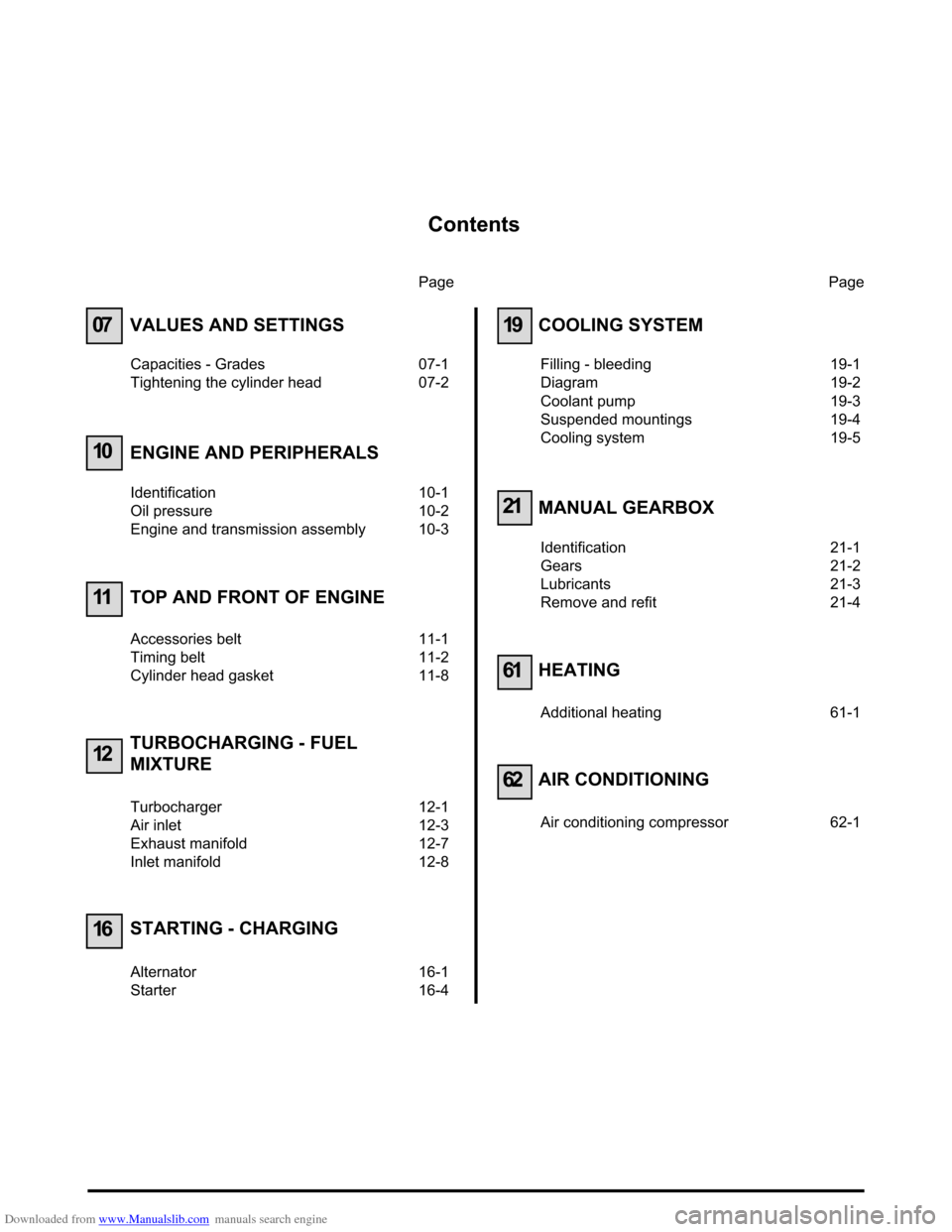
Downloaded from www.Manualslib.com manuals search engine Contents
Page
07
10
11
12
16
VALUES AND SETTINGS
Capacities - Grades 07-1
Tightening the cylinder head 07-2
ENGINE AND PERIPHERALS
Identification 10-1
Oil pressure 10-2
Engine and transmission assembly 10-3
TOP AND FRONT OF ENGINE
Accessories belt 11-1
Timing belt 11-2
Cylinder head gasket 11-8
TURBOCHARGING - FUEL
MIXTURE
Turbocharger 12-1
Air inlet 12-3
Exhaust manifold 12-7
Inlet manifold 12-8
STARTING - CHARGING
Alternator 16-1
Starter 16-4Page
19
21
61
62
COOLING SYSTEM
Filling - bleeding 19-1
Diagram 19-2
Coolant pump 19-3
Suspended mountings 19-4
Cooling system 19-5
MANUAL GEARBOX
Identification 21-1
Gears 21-2
Lubricants 21-3
Remove and refit 21-4
HEATING
Additional heating 61-1
AIR CONDITIONING
Air conditioning compressor 62-1
Page 3 of 52
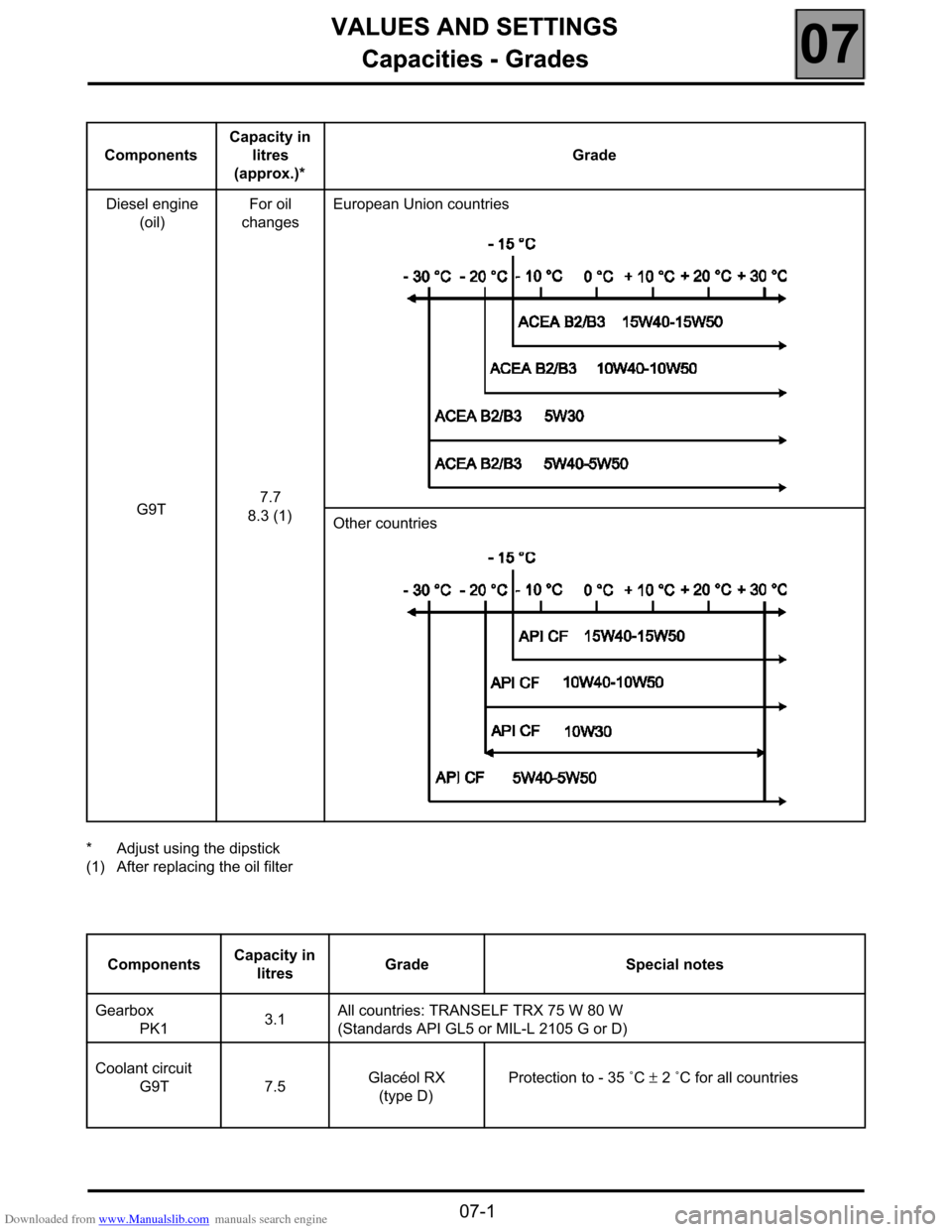
Downloaded from www.Manualslib.com manuals search engine VALUES AND SETTINGS
Capacities - Grades
07
107VALUES AND SETTINGS
Capacities - Grades
* Adjust using the dipstick
(1) After replacing the oil filterComponentsCapacity in
litres
(approx.)*Grade
Diesel engine
(oil)
G9TFor oil
changes
7.7
8.3 (1)European Union countries
Other countries
ComponentsCapacity in
litresGrade Special notes
Gearbox
PK13.1All countries: TRANSELF TRX 75 W 80 W
(Standards API GL5 or MIL-L 2105 G or D)
Coolant circuit
G9T 7.5Glacéol RX
(type D)Protection to - 35 ˚C ± 2 ˚C for all countries
07-1
Page 6 of 52
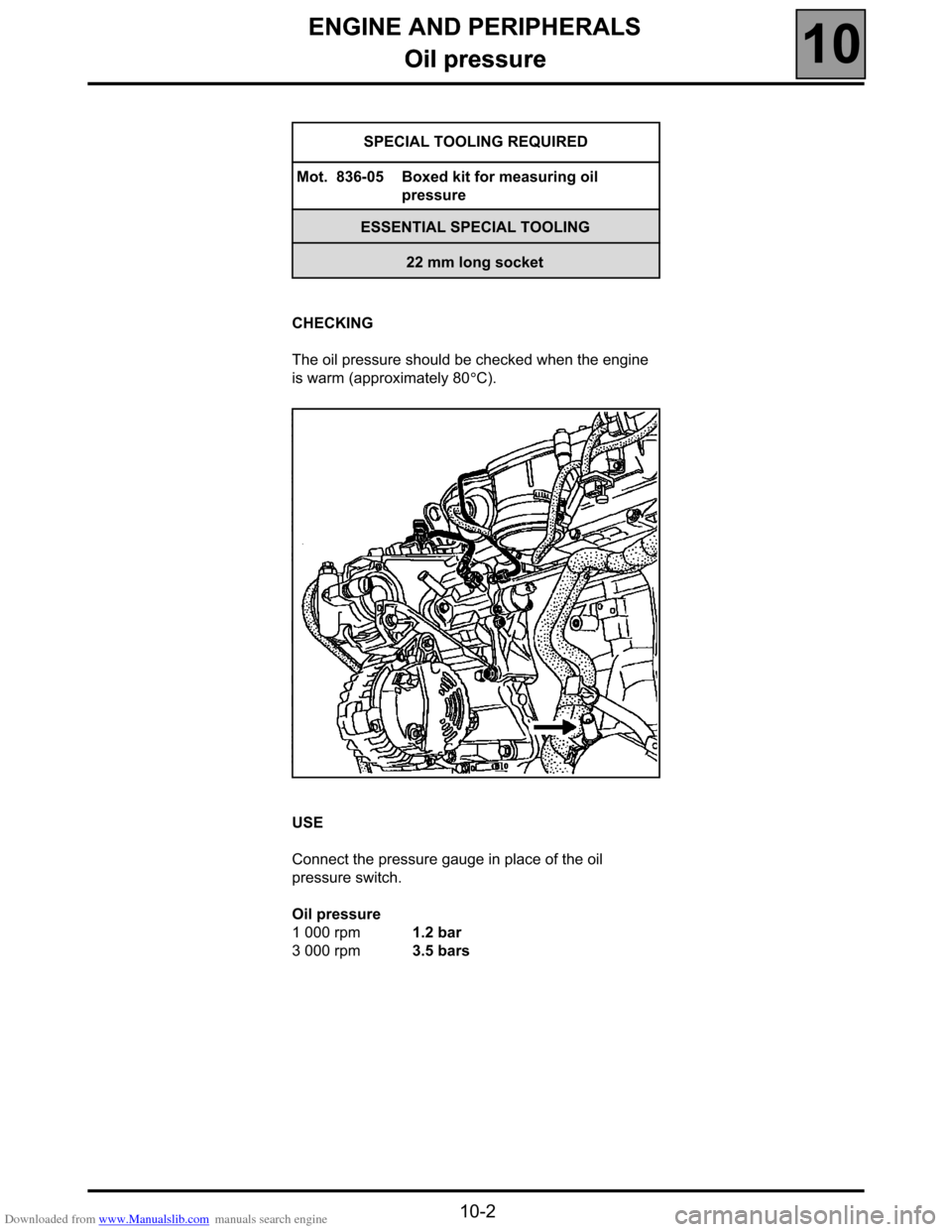
Downloaded from www.Manualslib.com manuals search engine ENGINE AND PERIPHERALS
Oil pressure
10
10-2
Oil pressure
CHECKING
The oil pressure should be checked when the engine
is warm (approximately 80°C).
USE
Connect the pressure gauge in place of the oil
pressure switch.
Oil pressure
1 000 rpm 1.2 bar
3 000 rpm 3.5 bars SPECIAL TOOLING REQUIRED
Mot. 836-05 Boxed kit for measuring oil
pressure
ESSENTIAL SPECIAL TOOLING
22 mm long socket
Page 23 of 52
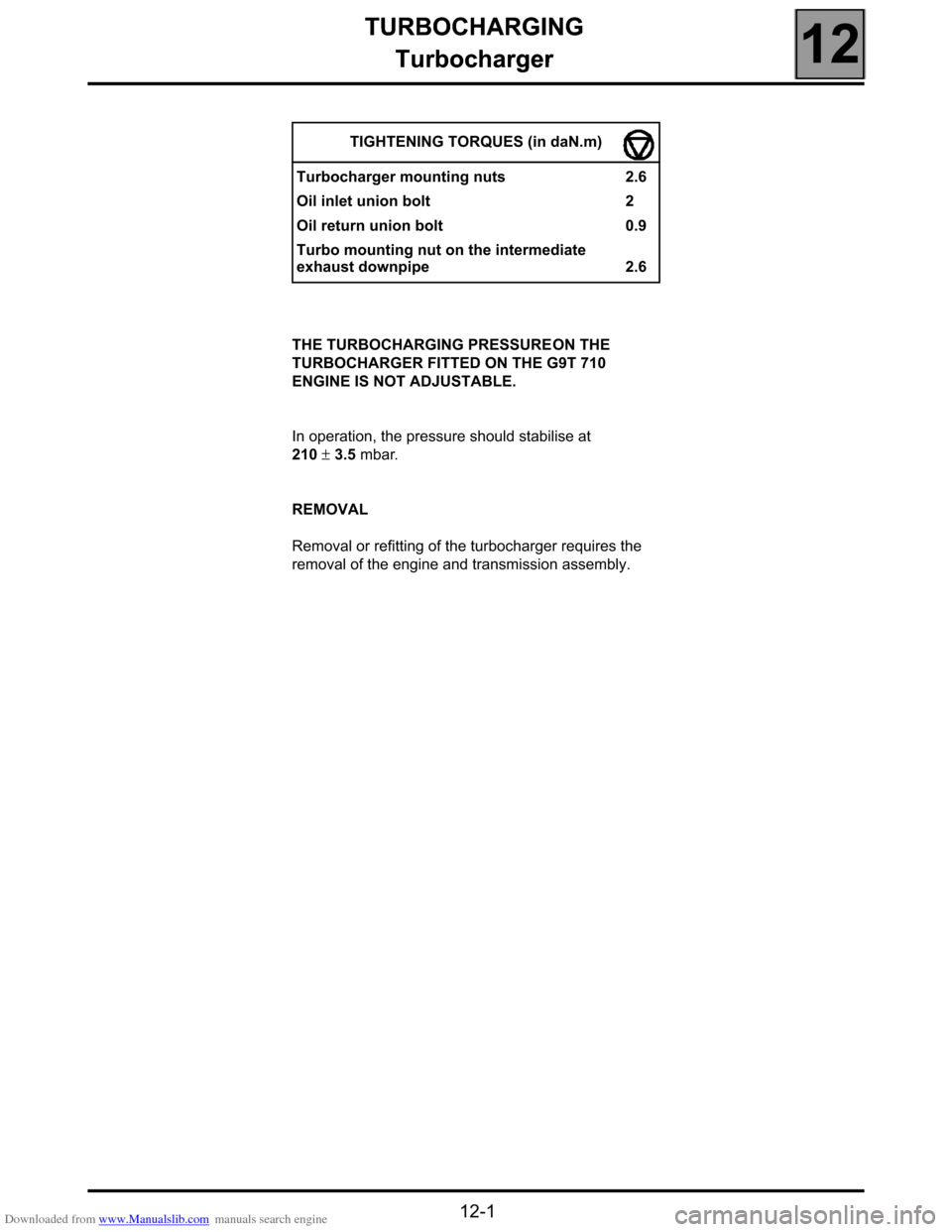
Downloaded from www.Manualslib.com manuals search engine TURBOCHARGING
Turbocharger
12
112TURBOCHARGING
Turbocharger
THE TURBOCHARGING PRESSURE ON THE
TURBOCHARGER FITTED ON THE G9T 710
ENGINE IS NOT ADJUSTABLE.
In operation, the pressure should stabilise at
210 ± 3.5 mbar.
REMOVAL
Removal or refitting of the turbocharger requires the
removal of the engine and transmission assembly.TIGHTENING TORQUES (in daN.m)
Turbocharger mounting nuts 2.6
Oil inlet union bolt 2
Oil return union bolt 0.9
Turbo mounting nut on the intermediate
exhaust downpipe 2.6
12-1
Page 24 of 52
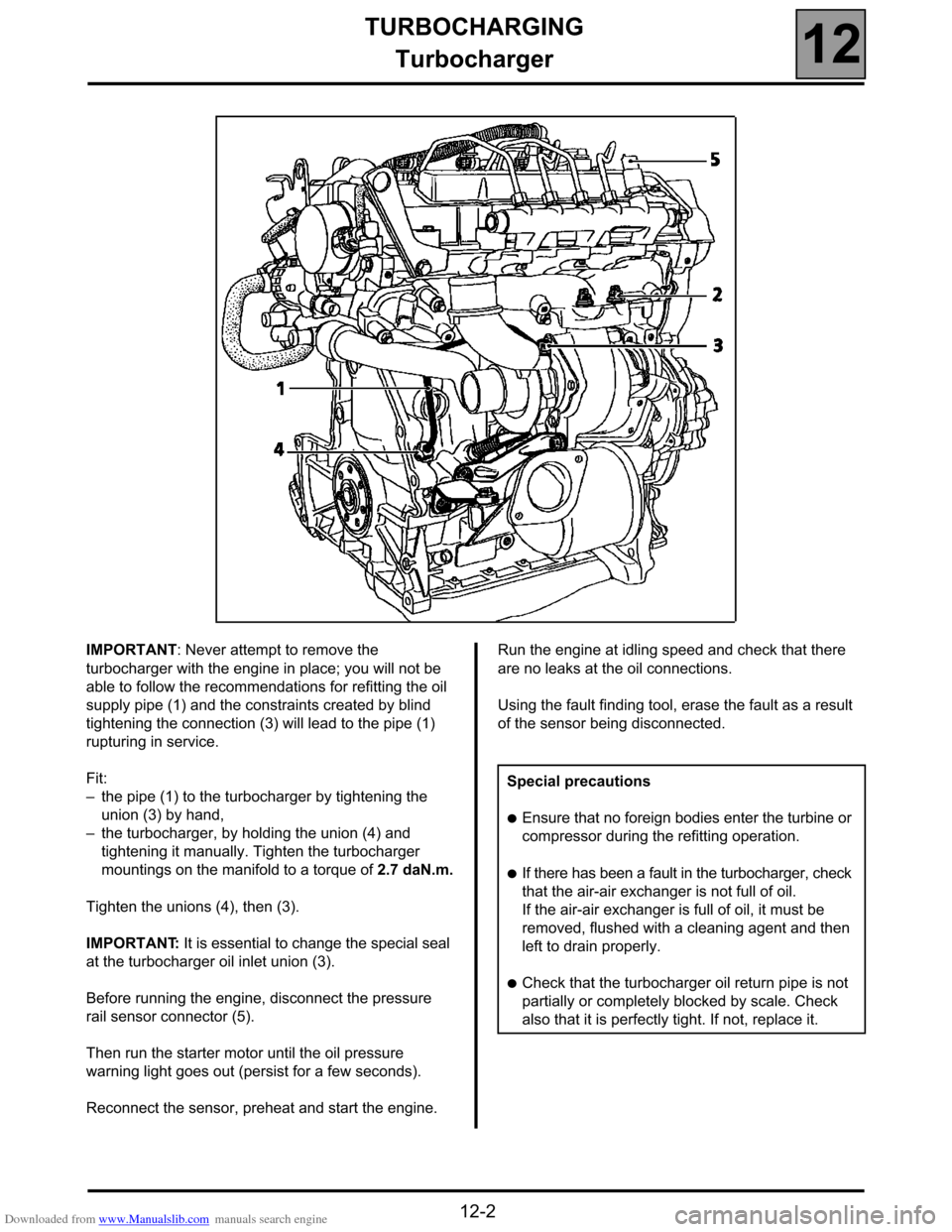
Downloaded from www.Manualslib.com manuals search engine TURBOCHARGING
Turbocharger
12
12-2
IMPORTANT: Never attempt to remove the
turbocharger with the engine in place; you will not be
able to follow the recommendations for refitting the oil
supply pipe (1) and the constraints created by blind
tightening the connection (3) will lead to the pipe (1)
rupturing in service.
Fit:
–the pipe (1) to the turbocharger by tightening the
union (3) by hand,
–the turbocharger, by holding the union (4) and
tightening it manually. Tighten the turbocharger
mountings on the manifold to a torque of 2.7 daN.m.
Tighten the unions (4), then (3).
IMPORTANT: It is essential to change the special seal
at the turbocharger oil inlet union (3).
Before running the engine, disconnect the pressure
rail sensor connector (5).
Then run the starter motor until the oil pressure
warning light goes out (persist for a few seconds).
Reconnect the sensor, preheat and start the engine.Run the engine at idling speed and check that there
are no leaks at the oil connections.
Using the fault finding tool, erase the fault as a result
of the sensor being disconnected.
Special precautions
●Ensure that no foreign bodies enter the turbine or
compressor during the refitting operation.
●If there has been a fault in the turbocharger, check
that the air-air exchanger is not full of oil.
If the air-air exchanger is full of oil, it must be
removed, flushed with a cleaning agent and then
left to drain properly.
●Check that the turbocharger oil return pipe is not
partially or completely blocked by scale. Check
also that it is perfectly tight. If not, replace it.
Page 27 of 52
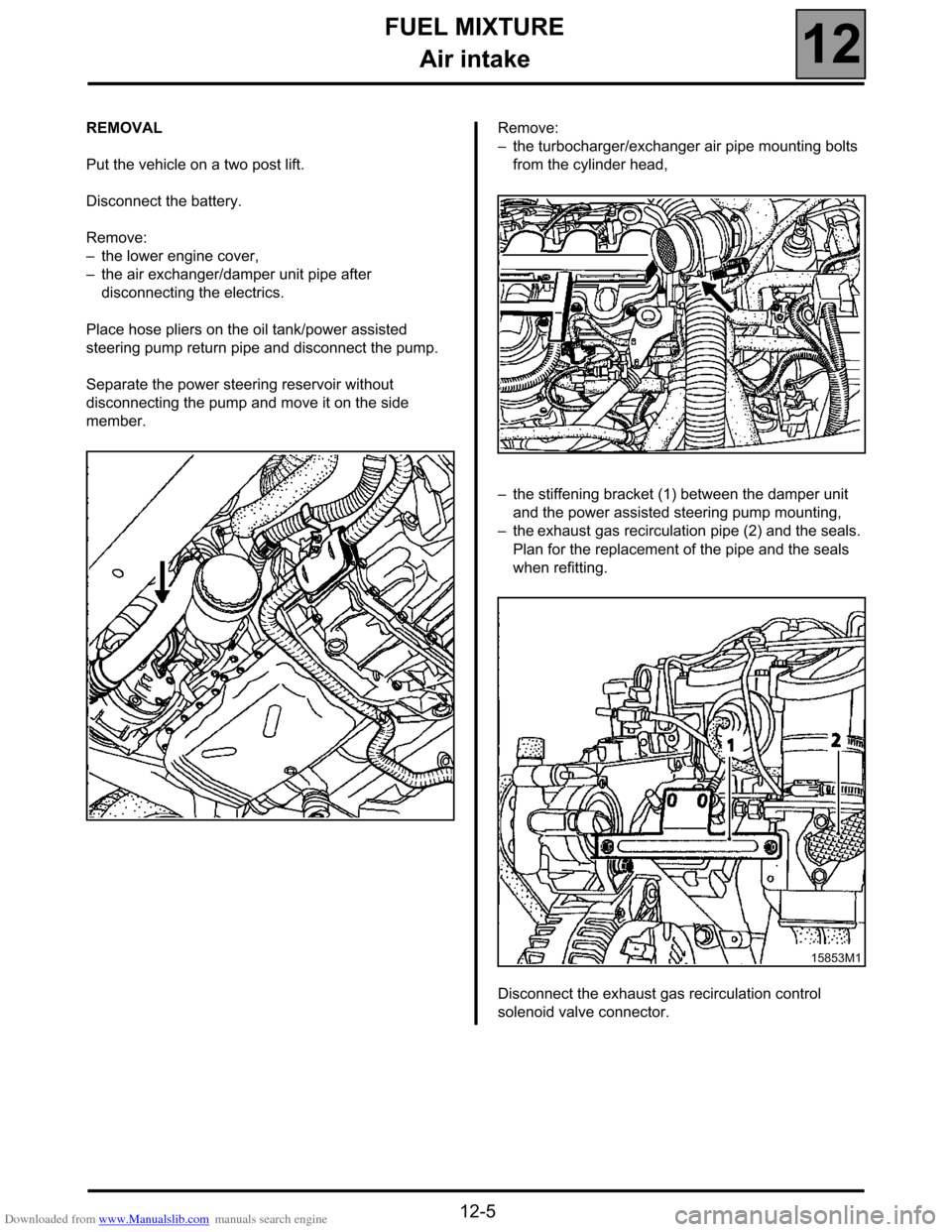
Downloaded from www.Manualslib.com manuals search engine FUEL MIXTURE
Air intake
12
12-5
REMOVAL
Put the vehicle on a two post lift.
Disconnect the battery.
Remove:
–the lower engine cover,
–the air exchanger/damper unit pipe after
disconnecting the electrics.
Place hose pliers on the oil tank/power assisted
steering pump return pipe and disconnect the pump.
Separate the power steering reservoir without
disconnecting the pump and move it on the side
member.Remove:
–the turbocharger/exchanger air pipe mounting bolts
from the cylinder head,
–the stiffening bracket (1) between the damper unit
and the power assisted steering pump mounting,
–the exhaust gas recirculation pipe (2) and the seals.
Plan for the replacement of the pipe and the seals
when refitting.
Disconnect the exhaust gas recirculation control
solenoid valve connector.
15853M1
Page 36 of 52
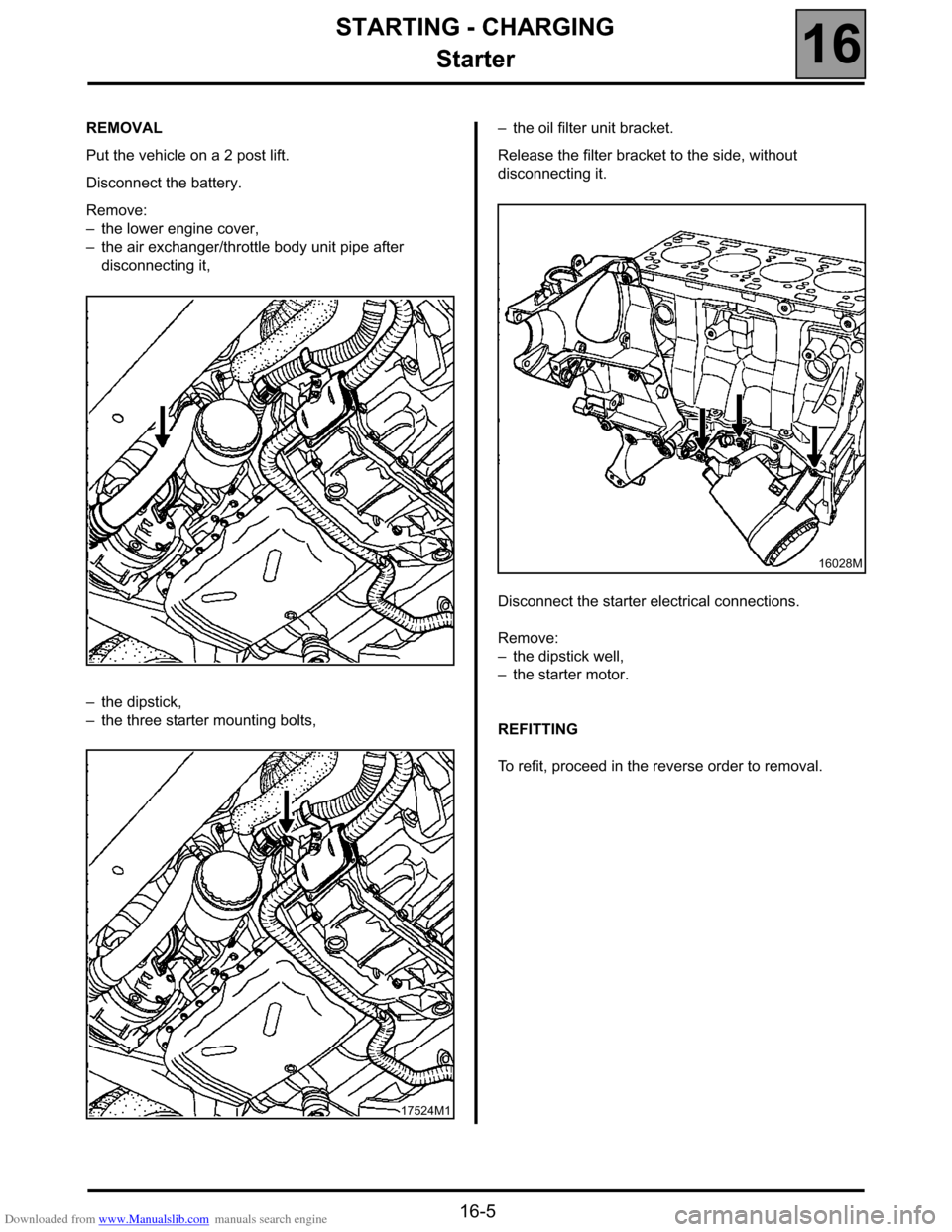
Downloaded from www.Manualslib.com manuals search engine STARTING - CHARGING
Starter
16
16-5
REMOVAL
Put the vehicle on a 2 post lift.
Disconnect the battery.
Remove:
–the lower engine cover,
–the air exchanger/throttle body unit pipe after
disconnecting it,
–the dipstick,
–the three starter mounting bolts,–the oil filter unit bracket.
Release the filter bracket to the side, without
disconnecting it.
Disconnect the starter electrical connections.
Remove:
–the dipstick well,
–the starter motor.
REFITTING
To refit, proceed in the reverse order to removal.
17524M1
16028M
Page 38 of 52
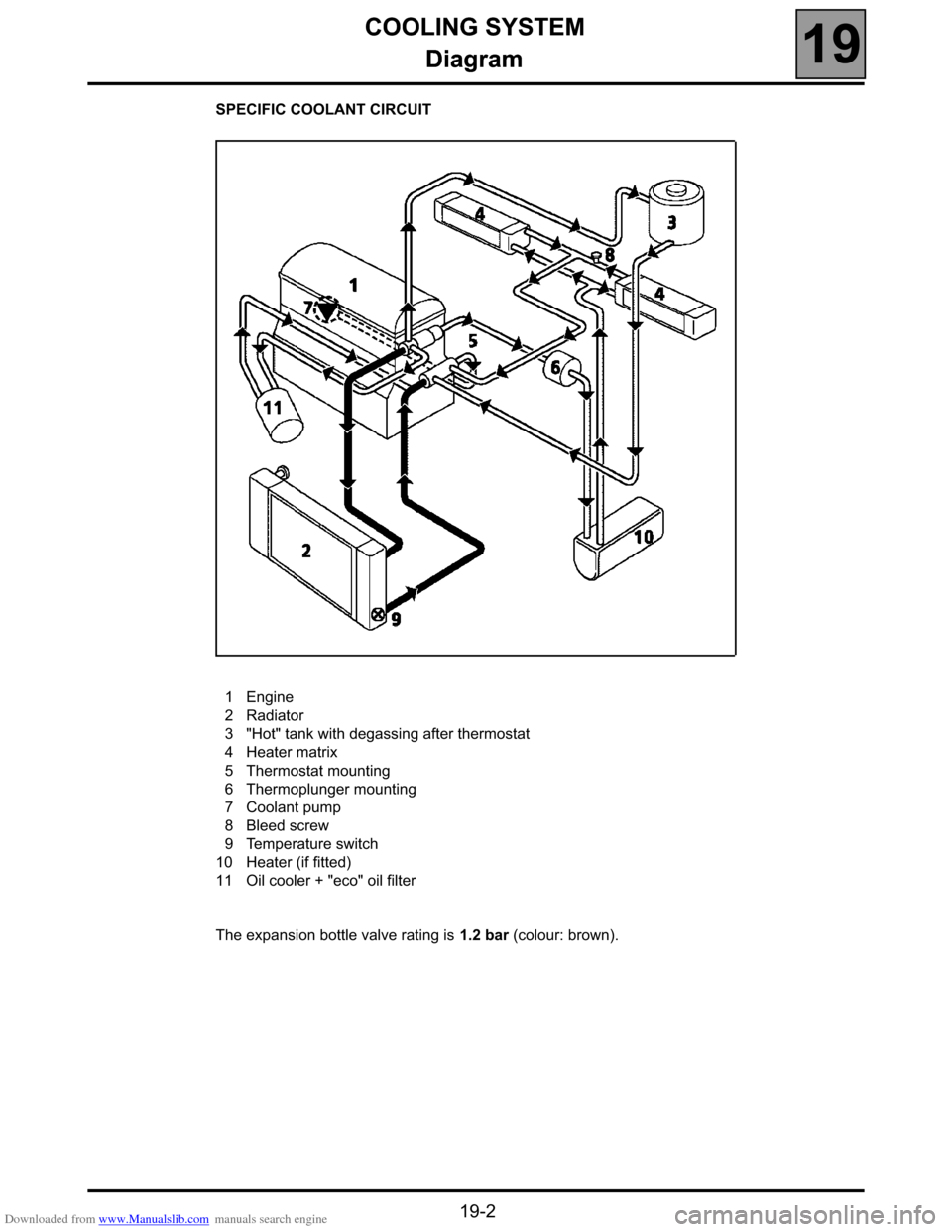
Downloaded from www.Manualslib.com manuals search engine COOLING SYSTEM
Diagram
19
19-2
Diagram
SPECIFIC COOLANT CIRCUIT
1Engine
2Radiator
3"Hot" tank with degassing after thermostat
4Heater matrix
5Thermostat mounting
6Thermoplunger mounting
7Coolant pump
8Bleed screw
9Temperature switch
10 Heater (if fitted)
11 Oil cooler + "eco" oil filter
The expansion bottle valve rating is 1.2 bar (colour: brown).
Page 39 of 52
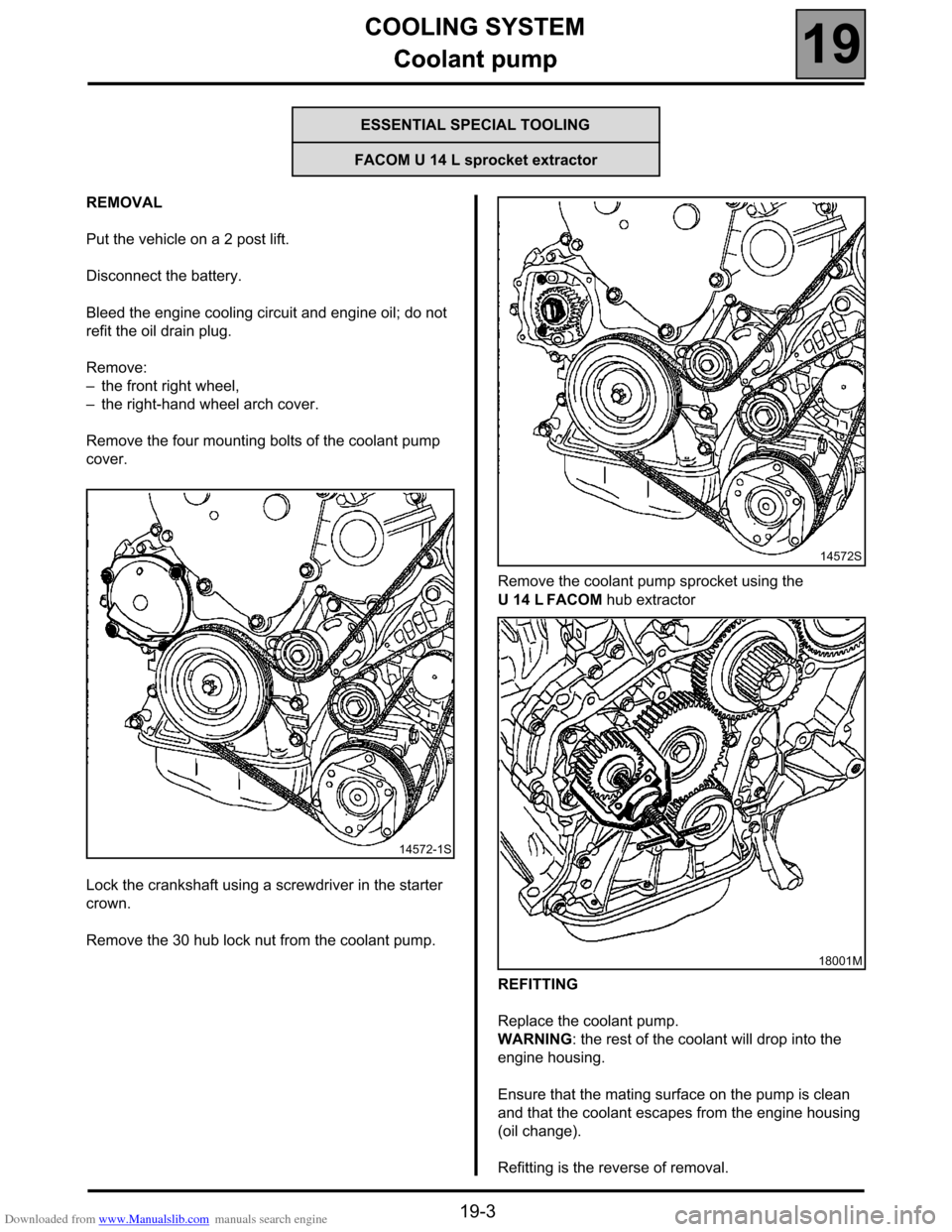
Downloaded from www.Manualslib.com manuals search engine COOLING SYSTEM
Coolant pump
19
19-3
Coolant pump
REMOVAL
Put the vehicle on a 2 post lift.
Disconnect the battery.
Bleed the engine cooling circuit and engine oil; do not
refit the oil drain plug.
Remove:
–the front right wheel,
–the right-hand wheel arch cover.
Remove the four mounting bolts of the coolant pump
cover.
Lock the crankshaft using a screwdriver in the starter
crown.
Remove the 30 hub lock nut from the coolant pump.Remove the coolant pump sprocket using the
U 14 L FACOM hub extractor
REFITTING
Replace the coolant pump.
WARNING: the rest of the coolant will drop into the
engine housing.
Ensure that the mating surface on the pump is clean
and that the coolant escapes from the engine housing
(oil change).
Refitting is the reverse of removal.
ESSENTIAL SPECIAL TOOLING
FACOM U 14 L sprocket extractor
14572-1S
14572S
18001M
Page 44 of 52
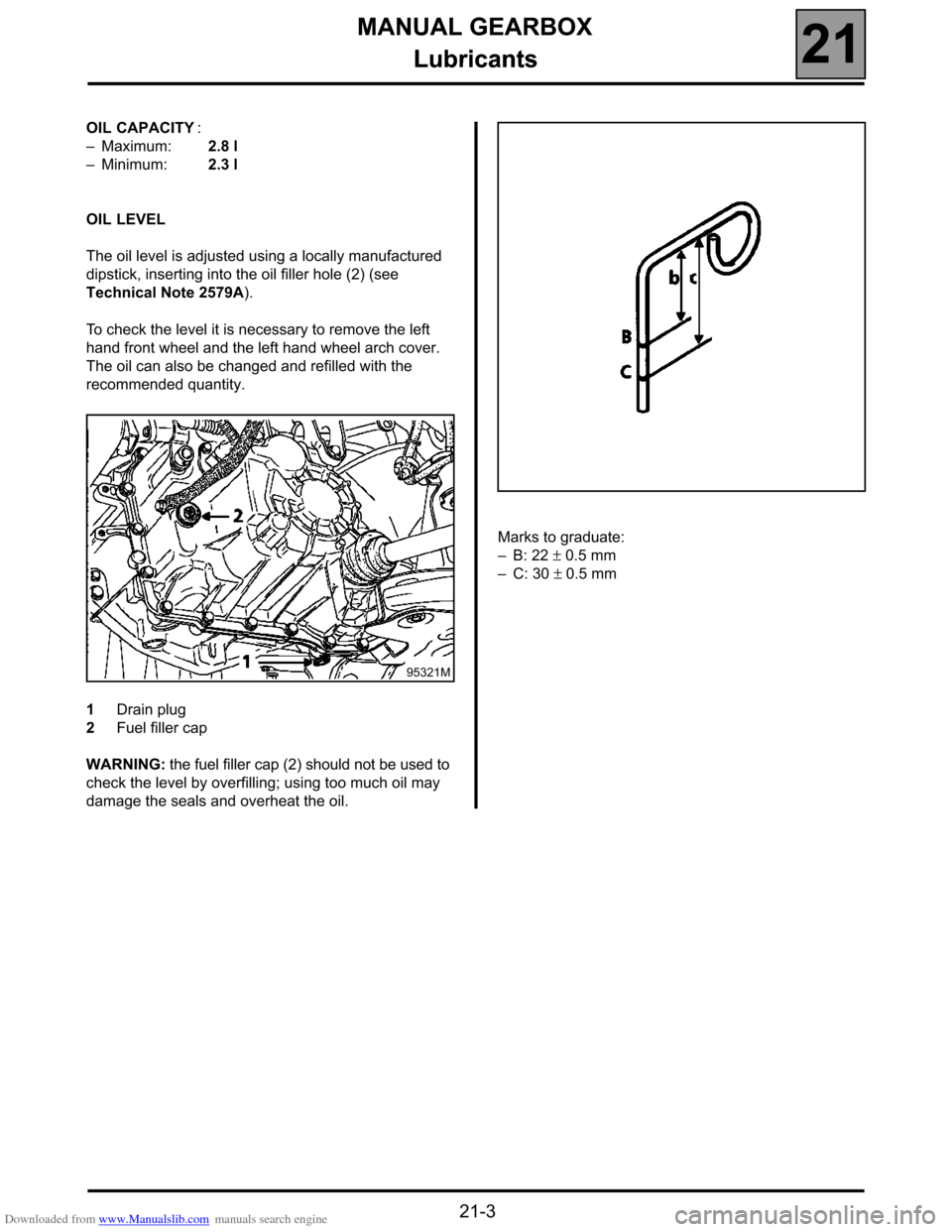
Downloaded from www.Manualslib.com manuals search engine MANUAL GEARBOX
Lubricants
21
21-3
Lubricants
OIL CAPACITY :
–Maximum: 2.8 l
–Minimum: 2.3 l
OIL LEVEL
The oil level is adjusted using a locally manufactured
dipstick, inserting into the oil filler hole (2) (see
Technical Note 2579A).
To check the level it is necessary to remove the left
hand front wheel and the left hand wheel arch cover.
The oil can also be changed and refilled with the
recommended quantity.
1 Drain plug
2 Fuel filler cap
WARNING: the fuel filler cap (2) should not be used to
check the level by overfilling; using too much oil may
damage the seals and overheat the oil. Marks to graduate:
–B: 22 ± 0.5 mm
–C: 30 ± 0.5 mm
95321M